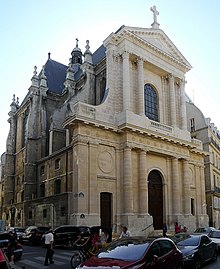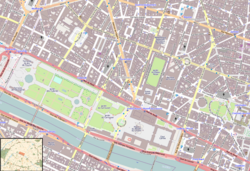Temple Protestant de l'Oratoire du Louvre
| l'Oratoire du Louvre | |
|---|---|
| Temple Protestant de l'Oratoire du Louvre | |

The front of the church from rue Saint Honoré
|
|
| 48°51′42.7″N 2°20′25.1″E / 48.861861°N 2.340306°ECoordinates: 48°51′42.7″N 2°20′25.1″E / 48.861861°N 2.340306°E | |
| Location | Paris |
| Country | France |
| Denomination | United Protestant Church of France |
| Previous denomination | Reformed Church of France |
| Churchmanship | Liberal |
| Website | oratoiredulouvre.fr |
| History | |
| Former name(s) | La congrégation de l’Oratoire de Jésus |
| Authorising papal bull | 1613 |
| Founded | November, 1611 |
| Founder(s) | Pierre de Bérulle |
| Consecrated | July 12, 1750 |
| Events | Made royal chapel of the Louvre Palace by Louis XIII (1623), Suppressed during the French Revolution (1792), Protestant Church (1811) |
| Associated people | Louis XIII, Cardinal Richelieu, Anne of Austria, Paul-Henri Marron |
| Architecture | |
| Status | Parish church |
| Functional status | Active |
| Heritage designation |
|
| Designated | 1907 |
| Architect(s) | Jacques Lemercier, Clément Métezeau, Pierre Caqué |
| Architectural type | Christian Church |
| Style | Baroque |
| Years built | 1621-1625, 1740-1745 |
| Groundbreaking | September 22, 1621 |
| Completed | 1745 |
| Administration | |
| Synod | Synode régional d'Île-de-France |
| Clergy | |
| Pastor(s) | Marc Pernot, James Woody |
The Temple Protestant de l'Oratoire du Louvre, also Eglise Réformée de l'Oratoire du Louvre, is a historic Protestant church located at 145 rue Saint-Honoré - 160 rue de Rivoli in the 1st arrondissement of Paris, across the street from the Louvre. It was founded in 1611 by Pierre de Bérulle as the French branch of the Oratory of Saint Philip Neri. It was made the royal chapel of the Louvre Palace by Louis XIII on December 23, 1623 and was host to the funerals of both Louis and Cardinal Richelieu. Work on the church was suspended in 1625 and not resumed until 1740, with the church completed in 1745.
It was suppressed in 1792 during the French Revolution, looted, stripped of its decor, and used to store theater sets. In 1811 it was given by Napoleon to the Protestant congregation of Saint-Louis-du-Louvre when that building was demolished to make way for the expansion of the Louvre. A statue and monument of Admiral Gaspard de Coligny, the great Huguenot leader of the 16th century, was built on the rue de Rivoli end of the church in 1889. It continues as one of the most prominent Reformed congregations in Paris, noted for its liberal theology. The closest métro station is Louvre – Rivoli ![]()
![]()
...
Wikipedia

